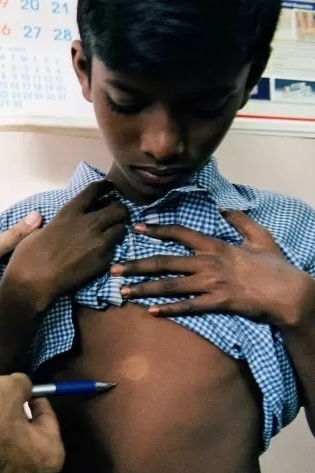10,813
Individuals already with visible disabilities at time of diagnostic
3 to 4 million
Persons cured from leprosy and now living with visible disabilities
132
Discrimatory laws worlwide affecting families experiencing leprosy


Individuals newly diagnosed with leprosy


Frequently Asked Questions
What causes leprosy?
Leprosy is a disease caused by a bacillus, Mycobacterium leprae. It multiplies very slowly and the incubation period can be a number of years (on average about 5 years).
What are the symptoms?
For many people the first signs of leprosy are pale patches of skin or numbness in the fingers or toes. This is because the disease mainly affects the nerves and skin. If left untreated, it can lead to nerve damage, loss of feeling (sensation) and paralysis of muscles in the hands, feet and face.
Can leprosy be cured?
Leprosy is treated effectively with multi drug therapy (MDT), a combination of three antibiotic drugs: dapsone, rifampicin and clofazimine. A six to twelve month course of treatment kills the bacteria and cures the person. If treated in the early stages of disease, MDT can prevent the onset of impairments and disabilities. Early diagnosis and prompt treatment of leprosy are essential.
Is leprosy contagious?
Leprosy is most likely transmitted by air through droplets from the nose and mouth, during close and frequent contacts with people who have not yet been treated. While it is spread in a similar way to the common cold, it is much less infectious. It multiplies slowly and the vast majority of people have adequate natural immunity, so don’t contract the disease if exposed. Once treatment begins, individuals become non-infectious within the first week of treatment.
What can be done to prevent leprosy?
The essential features of leprosy control are early detection and prompt treatment with MDT. In recent years there has been progress in other aspects of leprosy prevention, including contact management (tracing the contacts of new leprosy patients), chemoprophylaxis (giving a single dose of rifampicin to contacts of new leprosy patients) and immunoprophylaxis (Research and trials of a leprosy vaccine).
Is there stigma linked to leprosy?
Leprosy can be a devastating diagnosis, especially for people living in some of the world’s poorest and most marginalised communities. Individuals affected by leprosy often experience rejection, shame and social exclusion, with consequences for mental health. Stigma, prejudice, and discrimination can also prevent people with the symptoms of leprosy from seeking and accessing medical help, which delays diagnosis and treatment.
